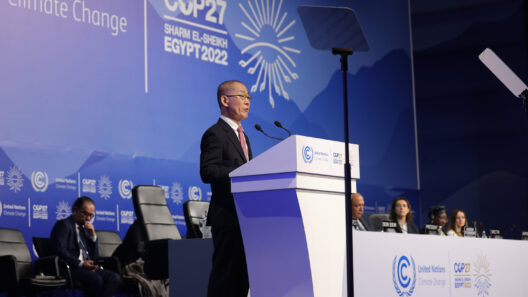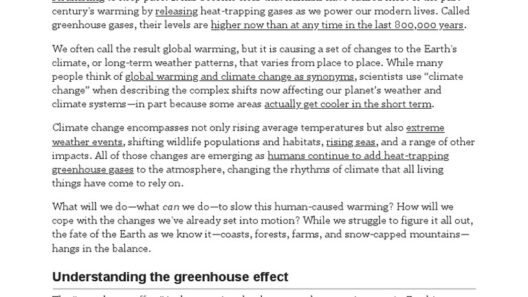Carbon dioxide (CO2) serves as a crucial element in our understanding of global warming, functioning as the master key to the puzzle of climate change. As the planet warms, it is imperative to dissect the multifaceted roles CO2 plays in this pressing issue. From its natural presence in the atmosphere to its anthropogenic contributions, the various dimensions of CO2 must be explored to fully comprehend its implications for our planet.
The greenhouse effect, a natural phenomenon essential for sustaining life, results primarily from certain gases, including CO2. When solar radiation reaches Earth, some of it is absorbed, while the remainder is reflected back into space. Greenhouse gases, including carbon dioxide, trap some of this outgoing heat, thereby regulating the planet’s temperature. Without this effect, Earth would be inhospitably cold, averaging around -18 degrees Celsius instead of the current 15 degrees. However, an increase in concentrations of these gases leads to an enhanced greenhouse effect, resulting in global warming.
Historically, CO2 levels have fluctuated naturally due to volcanic eruptions, oceanic exchanges, and photosynthetic activities of plants. However, since the Industrial Revolution, human activities—particularly the burning of fossil fuels—have significantly augmented CO2 concentrations. Presently, atmospheric CO2 levels exceed 400 parts per million (ppm), a concentration unprecedented in at least 800,000 years. The ramifications of this surge are profound and warrant meticulous examination.
The ramifications of elevated CO2 levels are manifold, contributing to various environmental tribulations. For one, higher CO2 concentrations promote the greenhouse effect, leading to rising global temperatures. As temperatures climb, the consequences manifest through more frequent and severe weather events, including hurricanes, droughts, and floods. Such climatic extremes not only disrupt ecosystems but also have dire implications for human health, agriculture, and infrastructure.
Additionally, CO2 interacts with the oceans, resulting in acidification. The world’s oceans act as a significant carbon sink, absorbing approximately one-quarter of emitted CO2. This process helps mitigate the greenhouse effect but comes at a steep cost. Oceanic absorption alters the pH of seawater, threatening marine biodiversity. Coral reefs, often referred to as the “rainforests of the sea,” are particularly vulnerable; even modest pH reductions can lead to coral bleaching, undermining entire marine ecosystems and the fisheries they support.
The intersection of CO2 emissions and human activities is starkly illustrated in transportation, energy production, and deforestation. The transportation sector relies heavily on fossil fuels, contributing about 14% of global greenhouse gas emissions. Every vehicle that burns gasoline or diesel emits not just CO2 but also a host of other pollutants. Shifting to electric vehicles and improving public transportation systems can mitigate emissions significantly.
Energy production, particularly from coal, oil, and natural gas, remains the dominant source of anthropogenic CO2 emissions. The reliance on these energy sources has led to an unsustainable carbon footprint. Transitioning to renewable energy sources—such as solar, wind, and hydroelectric power—represents a pivotal solution to curbing CO2 emissions. The integration of cleaner technologies not only lowers emissions but also fosters energy security and economic growth.
Meanwhile, deforestation exacerbates the challenge. Trees act as carbon sinks, absorbing CO2 from the atmosphere. When forests are cleared, not only is this carbon-absorbing capability diminished, but the carbon stored within the trees is released back into the atmosphere. Sustainable land management practices and reforestation are crucial strategies for carbon sequestration, allowing nature to aid in the fight against climate change.
Additionally, solutions focused on carbon capture and storage (CCS) technologies are being developed to capture CO2 emissions at their source, preventing them from entering the atmosphere. These technologies are promising but remain costly and complex. Investment in research and innovation is essential for making CCS feasible and efficient in large-scale applications.
Beyond immediate technological fixes, addressing CO2 emissions necessitates a paradigmatic shift in societal behavior and policy. Governments and organizations globally must commit to comprehensive climate action plans that prioritize emissions reductions. Policies such as carbon pricing, which assigns a cost to carbon emissions, can serve as a deterrent for high-emission activities while promoting greener alternatives.
Public awareness and education play a critical role in this endeavor. Understanding the integral link between CO2 and climate change galvanizes individuals and communities to advocate for sustainable practices. Environmental stewardship must be embraced at both the individual and collective levels to amplify the impact of policies targeting emissions reductions.
In conclusion, CO2 is not merely a chemical compound; it is the fulcrum upon which the gears of global warming pivot. Its proliferation driven by human activities propels an array of climatic challenges that necessitate urgent attention. Tackling CO2 emissions represents an indispensable step towards mitigating climate change, safeguarding ecosystems, and ensuring a sustainable future. The fight against global warming requires tenacity, innovation, and widespread commitment to transformative solutions. Every action, from policy changes to individual lifestyle adjustments, can contribute to a more stable climate, underscoring the significance of CO2 as the master key to understanding and combating global warming.







